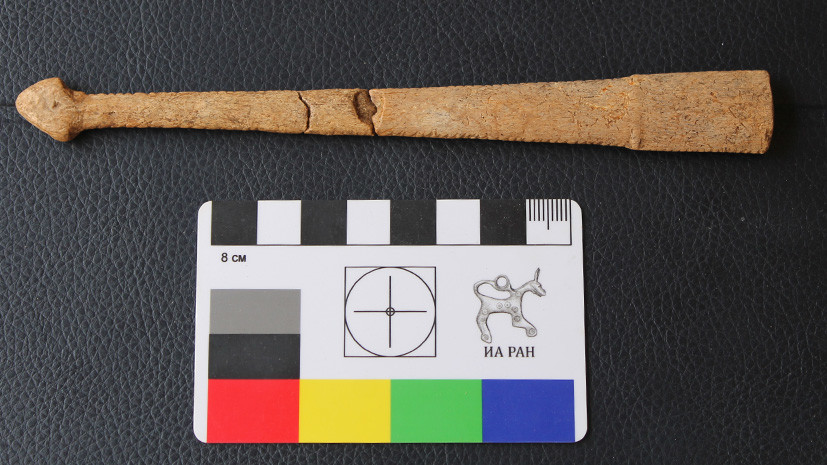Members of the expedition of the Institute of Archeology of the Russian Academy of Sciences (IA RAS) discovered in the Bryansk region a sacred fire of people of the Upper Paleolithic (Late Stone Age), which was used 23,000 years ago by ancient people to conduct rituals. This was reported by the press service of the institute.
The Upper Paleolithic sites of Khotylevo-1 and Khotylevo-2, 25 km from Bryansk, were discovered and explored in the middle of the last century by the Soviet archaeologist Fedor Zavernyaev. In 1993, a member of the IA RAS Konstantin Gavrilov resumed the work begun by his predecessor, and the scientists of the Khotylev archaeological expedition again began to regularly make discoveries in ancient sites after a long break.
Radiocarbon analysis showed that people lived in these places from 28 to 20 thousand years ago. Scientists note that during this period the last glaciers in Europe were already retreating to the north, and in the forest-steppe of the Russian Plain, our ancestors had to get along with mammoths, reindeer, giant brown bears and cave lions.
- Parking Hotylevo-2. General view of the excavation
- © Press Service of the Institute of Archeology of the Russian Academy of Sciences
Gavrilov’s team managed to increase the investigated area of the Khotylevo-2 parking lot from about 500 to 700 square meters. m, and in the current archaeological season, scientists have discovered the central part of the site, which 23 thousand years ago, people used as a ritual bonfire.
Excavated fragments of mammoth bones, objects hidden beneath them and their location leave no doubt that this site served for certain rites, archaeologists are sure.
“We reveal fragments of the complex that suggest their sacral nature: an abundance of ocher, bones of a mammoth, a hole, flocks of flint stacked and dug in a certain order, works of art, such as statues of Paleolithic Venus. Excavations in 2019 revealed the central part of the site on which the fireplace was located, the structure of the monument was determined, and an artifact carved from the bone was discovered, analogues of which are not yet known, ”said Konstantin Gavrilov.
Since 2005, at the Khotylevo-2 parking lot, archaeologists have found artifacts that lay on ocher dusted ground, sometimes were covered with fragments of mammoth bones on top. During the excavations of this season, it became obvious that the finds form an oval, in the center of which there was a fireplace. In addition, an artifact was discovered that had not previously been found in any Paleolithic site, archaeologists say.
- Artifact made from the compact part of the mammoth bone. Hotylevo-2
- © Press Service of the Institute of Archeology of the Russian Academy of Sciences
An unusual object of 16 centimeters in length has a narrow body and an asymmetric top. At the edges it is decorated with an ornament consisting of oblique crosses, arrows and parallel cuts. According to scientists of the Paleontological Institute of the Russian Academy of Sciences, the artifact is made of the compact part of a very large tubular bone of a woolly mammoth. His appointment has not yet been unraveled.
“Now we can only say that this object did not perform any rough operations ... Since it is very thin in its narrow part, it could not withstand heavy mechanical loads - it would break ... The place of discovery and the objects that surrounded it , clearly indicate that it was used for symbolic, most likely ritual purposes, ”said Konstantin Gavrilov.
Also on an ancient campfire, scientists discovered an ancient primitive figurines lined by an arc - Paleolithic Venus. One of them was laid in a hole next to a cluster of large flint plates and ocher-stained fragments of mammoth bones. A double female figurine carved from chalk was found next to another pit: both female figures are depicted shoulder to shoulder using the bas-relief technique.
Among other findings, there is a complex structure of a fossilized shell of a fossil marine mollusk, a fragment of the skull of a large mammal, and vertically standing flint plates. Not far from the group with a shell, an ocher-colored fang of a 500-kilogram brown bear male, which served as a hunting trophy or amulet, was stuck in the ground, the researchers believe.
“From the ethnographic materials we know the rituals accompanying the celebration of a successful hunt: the hunter who killed the beast had to make a sacrifice in order to propitiate the spirit of the beast and ensure its continuation. Perhaps, it was precisely here that similar rituals were held, which were accompanied by ritual feasts - numerous animal bones and large accumulations of coal indicate this, ”concluded Konstantin Gavrilov.

